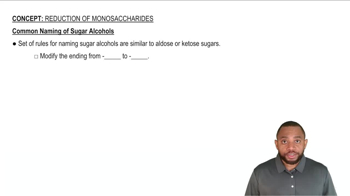Textbook Question
Identify the following reactions as condensation or hydrolysis:
(a) two monosaccharides reacting to form a disaccharide
17
views
 Verified step by step guidance
Verified step by step guidance



Identify the following reactions as condensation or hydrolysis:
(a) two monosaccharides reacting to form a disaccharide
Name the glycosidic bond present in mannobiose, shown in the following figure:
<IMAGE>
Mannobiose
Explain the difference between an oligosaccharide and a polysaccharide.
Describe the properties of soluble fiber.
Name the functional groups present in aldoses.
How are the following pairs of carbohydrates, shown in a Fischer projection, related to each other? Are they structural isomers, enantiomers, diastereomers, or epimers?
(a) <IMAGE>